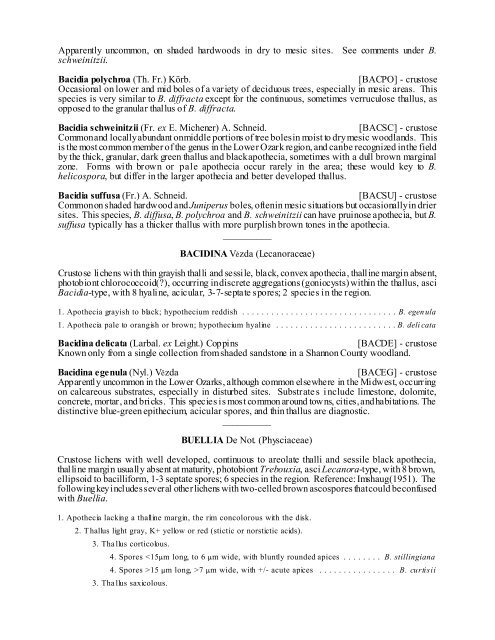lichens of the lower ozark region of missouri and arkansas
lichens of the lower ozark region of missouri and arkansas
lichens of the lower ozark region of missouri and arkansas
You also want an ePaper? Increase the reach of your titles
YUMPU automatically turns print PDFs into web optimized ePapers that Google loves.
Apparently uncommon, on shaded hardwoods in dry to mesic sites. See comments under B.<br />
schweinitzii.<br />
Bacidia polychroa (Th. Fr.) Körb. [BACPO] - crustose<br />
Occasional on <strong>lower</strong> <strong>and</strong> mid boles <strong>of</strong> a variety <strong>of</strong> deciduous trees, especially in mesic areas. This<br />
species is very similar to B. diffracta except for <strong>the</strong> continuous, sometimes verruculose thallus, as<br />
opposed to <strong>the</strong> granular thallus <strong>of</strong> B. diffracta.<br />
Bacidia schweinitzii (Fr. ex E. Michener) A. Schneid. [BACSC] - crustose<br />
Common <strong>and</strong> locally abundant on middle portions <strong>of</strong> tree boles in moist to dry mesic woodl<strong>and</strong>s. This<br />
is <strong>the</strong> most common member <strong>of</strong> <strong>the</strong> genus in <strong>the</strong> Lower Ozark <strong>region</strong>, <strong>and</strong> can be recognized in <strong>the</strong> field<br />
by <strong>the</strong> thick, granular, dark green thallus <strong>and</strong> black apo<strong>the</strong>cia, sometimes with a dull brown marginal<br />
zone. Forms wi th brown or pale apo<strong>the</strong>cia occur rarely in <strong>the</strong> area; <strong>the</strong>se would key to B.<br />
helicospora, but differ in <strong>the</strong> larger apo<strong>the</strong>cia <strong>and</strong> better developed thallus.<br />
Bacidia suffusa (Fr.) A. Schneid. [BACSU] - crustose<br />
Common on shaded hardwood <strong>and</strong> Juniperus boles, <strong>of</strong>ten in mesic situations but occasionally in drier<br />
sites. This species, B. diffusa, B. polychroa <strong>and</strong> B. schweinitzii can have pruinose apo<strong>the</strong>cia, but B.<br />
suffusa typically has a thicker thallus with more purplish brown tones in <strong>the</strong> apo<strong>the</strong>cia.<br />
__________<br />
BACIDINA V�zda (Lecanoraceae)<br />
Crustose <strong>lichens</strong> with thin grayish thalli <strong>and</strong> sessile, black, convex apo<strong>the</strong>cia, thalline margin absent,<br />
photobiont chlorococcoid(?), occurring in discrete aggregations (goniocysts) within <strong>the</strong> thallus, asci<br />
Bacidia-type, with 8 hyaline, acicular, 3-7-septate spores; 2 species in <strong>the</strong> <strong>region</strong>.<br />
1. Apo<strong>the</strong>cia grayish to black; hypo<strong>the</strong>cium reddish ................................B. egenula<br />
1. Apo<strong>the</strong>cia pale to orangish or brown; hypo<strong>the</strong>cium hyaline .........................B. deli cata<br />
Bacidina delicata (Larbal. ex Leight.) Coppins [BACDE] - crustose<br />
Known only from a single collection from shaded s<strong>and</strong>stone in a Shannon County woodl<strong>and</strong>.<br />
Bacidina egenula (Nyl.) V�zda [BACEG] - crustose<br />
Apparentl y uncommon in <strong>the</strong> Lower Ozarks, although common elsewhere in <strong>the</strong> Midwest, occurring<br />
on calcareous substrates, especially in disturbed sites. Substrate s i nclude limestone, dolomite,<br />
concrete, mortar, <strong>and</strong> bricks. This species is most common around towns, cities, <strong>and</strong> habitations. The<br />
distinctive blue-green epi<strong>the</strong>cium, acicular spores, <strong>and</strong> thin thallus are diagnostic.<br />
__________<br />
BUELLIA De Not. (Physciaceae)<br />
Crustose <strong>lichens</strong> with well developed, continuous to areolate thalli <strong>and</strong> sessile black apo<strong>the</strong>cia,<br />
thal line margin usually absent at maturity, photobiont Trebouxia, asci Lecanora-type, with 8 brown,<br />
ellipsoid to bacilliform, 1-3 septate spores; 6 species in <strong>the</strong> <strong>region</strong>. Reference: Imshaug (1951). The<br />
following key includes several o<strong>the</strong>r <strong>lichens</strong> with two-celled brown ascospores that could be confused<br />
with Buellia.<br />
1. Apo<strong>the</strong>cia lacking a thalline margin, <strong>the</strong> rim concolorous with <strong>the</strong> disk.<br />
2. Thallus light gray, K+ yellow or red (stictic or norstictic acids).<br />
3. Thallus corticolous.<br />
4. Spores 15 �m long, >7 �m wide, with +/- acute apices ................ B. curtisii<br />
3. Thallus saxicolous.


